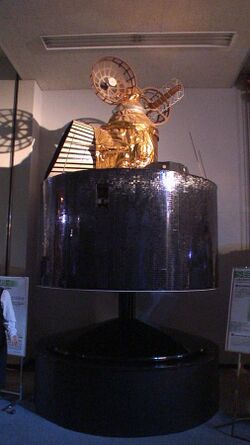Engineering:Himawari (satellite)
From HandWiki
Short description: Geostationary Meteorological Satellite

The Himawari (ひまわり, “sunflower”) geostationary satellites, operated by the Japan Meteorological Agency (JMA), support weather forecasting, tropical cyclone tracking, and meteorology research. Most meteorological agencies in East Asia, Southeast Asia, Australia and New Zealand use the satellites for their own weather monitoring and forecasting operations.
Originally also named Geostationary Meteorological Satellites (GMS),[1] since the launch of GMS-1 (Himawari 1) in 1977, there have been three generations, including GMS, MTSAT, and Himawari 8/9. Himawari 8/9 satellites are currently available for operational use.
Status
| Name | Launch date (UTC) |
Retirement | Rocket | Launch site |
|---|---|---|---|---|
| GMS-1 (Himawari 1) | 14 July 1977 | June 1989 | Delta 2914 | Cape Canaveral Air Force Station |
| GMS-2 (Himawari 2) | 11 August 1981 | November 1987 | N-II (N8F) | Tanegashima |
| GMS-3 (Himawari 3) | 3 August 1984 | June 1995 | N-II (N13F) | Tanegashima |
| GMS-4 (Himawari 4) | 6 September 1989 | February 2000 | H-I (H20F) | Tanegashima |
| GMS-5 (Himawari 5) | 18 March 1995 | July 2005 | H-II (F3) | Tanegashima |
| MTSAT-1 (Mirai 1) | 15 November 1999 | Launch failure | H-II (F8) | Tanegashima |
| MTSAT-1R (Himawari 6) | 26 February 2005 | 4 December 2015 | H-IIA (F7) | Tanegashima |
| MTSAT-2 (Himawari 7) | 18 February 2006 | 10 March 2017 | H-IIA (F9) | Tanegashima |
| Himawari 8 | 7 October 2014 | Operational | H-IIA (F25) | Tanegashima |
| Himawari 9 | 2 November 2016 | Stand-by | H-IIA (F31) | Tanegashima |
See also
- Japan Meteorological Agency (JMA)
References
- ↑ "Exchange of Letters constituting an Agreement between the Government of Australia and the Government of Japan concerning Co-operation on the Project for the Geostationary Meteorological Satellite-4 System ATS 28 of 1990”. Australasian Legal Information Institute, Australian Treaties Library. Retrieved on 15 April 2017.
External links
